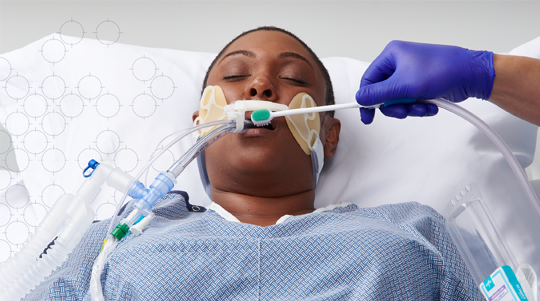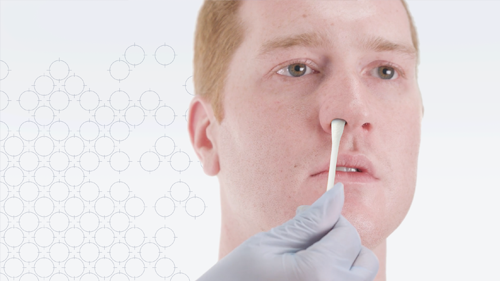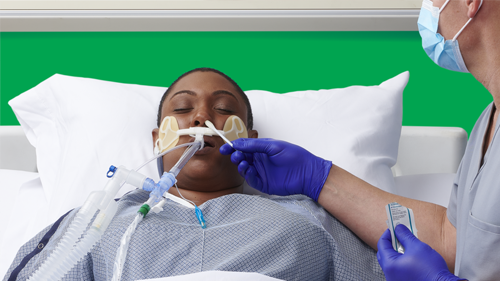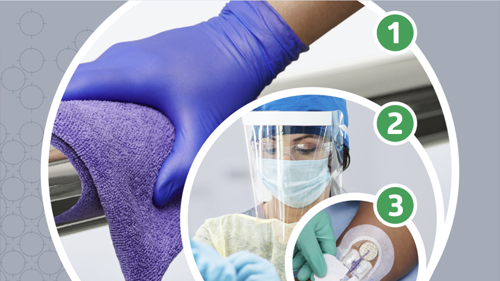Daily CHG bath for each patient: Strategies for implementing
Learn how to use chlorhexidine gluconate solution to help reduce HAI risk.
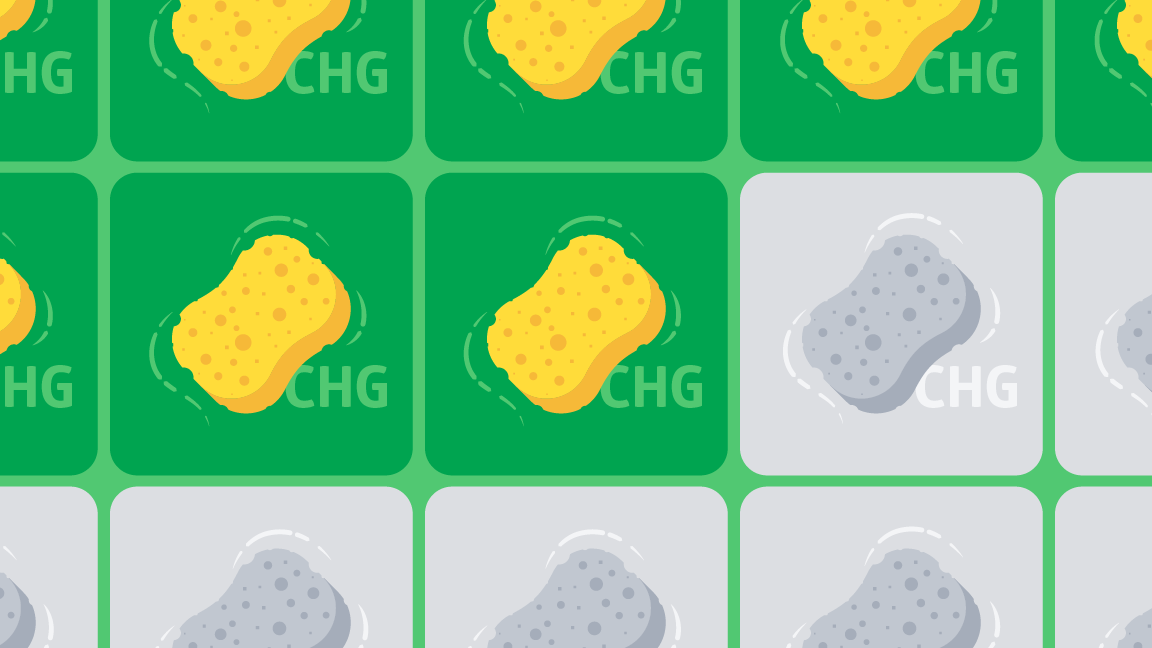
It’s hard enough to prevent healthcare-associated infections (HAIs) without multidrug-resistant organisms (MDROs) compounding the challenge:
- The Centers for Disease Control and Prevention (CDC) estimates that more than 2 million people become infected with bacteria resistant to antibiotics and that MDROs account for 23,000 deaths per year1
- The share of bacterial infections associated with MDROs doubled between 2002 and 2014 in the United States1
How can you protect patients—as well as staff and visitors—from these organisms?
Chlorhexidine gluconate (CHG), an antiseptic with broad-spectrum antimicrobial activity, has been shown in several studies to be an important component of infection prevention in intensive care units (ICUs). Providing patients with daily CHG baths has led to declines in central line associated-bloodstream infections (CLABSIs), other healthcare-associated BSIs (HABSIs) and acquisition of MDROs.2 In fact, patient bathing with CHG significantly has reduced the incidence of HABSIs in both ICU and non-ICU settings.3
Here are ways an infection preventionist can take the lead in putting a daily CHG bathing protocol into practice.
Develop and implement the CHG bathing protocol
The protocol should outline the appropriate use of CHG solution and the proper technique for bathing patients. For example, to use for patient bathing, the CHG could be applied as a 4% solution.4
Choose a bathing practice
“Infection preventionists need to make sure they are able to get the supplies they need, such as CHG solution, personal protective equipment and equipment for bathing,” says Caryn Arnold, MBA, RN, BSN, CNOR(E), a-IPC, Medline Medical Science Liaison. “To do that, they need to address any issues with their bathing practice of choice.”
Let’s say you decide to use CHG solution with basins. Basins can become contaminated. Arnold says that to prevent contamination, the following practice can be considered:
- Place cloths in the basin and fill the basin with clean, warm water
- Take a warm, wet cloth out, apply the CHG to the cloth and bathe the patient
- Discard the cloth so nothing dirty ever goes back into the basin
- Empty the basin and use a disinfecting wipe on it
- Keep the basin bedside, ensuring that nothing is stored in it
“You also can use basin liners or disposable basins,” adds Arnold.
In addition, you’ll need to decide what materials to use to apply the CHG, such as non-cotton cloths or sponges.
Assess patient populations
Patients with a history of allergies or skin sensitivities should be identified and special precautions taken when performing CHG bathing. It is important to ensure that the solution does not come into contact with mucous membranes or open wounds.
Take into consideration that patients in different units will need different bathing techniques. For example:
- Oncology: Patients’ skin may be more sensitive. It may be necessary to use a lower concentration of CHG solution or to limit the frequency of CHG baths to prevent skin irritation or other adverse reactions.
- ICU: Patients’ skin may be more fragile. To reduce the risk of skin breakdown, the use of a mild or no-rinse CHG solution may be necessary. In addition, the frequency of CHG bathing may need to be addressed to prevent the spread of infection in this high-risk patient population.
- Burn units: To prevent further damage to patients’ skin, a gentle, non-abrasive approach may be necessary. Extra care should be taken to ensure that the solution does not come into contact with open wounds.
Overall, keep in mind that the CHG bathing process should be sustainable over the long term, meaning it should be cost-effective, efficient and easy to implement.
Involve frontline staff
Make sure to include staff input as you develop the protocol to increase their buy-in, engagement and compliance. If you implement a process that staff can’t carry out, you won’t achieve your goals.
“It’s usually the certified nursing assistants who are going to be doing the CHG bathing,” says Arnold. “They’ll need to have time to do it.”
CNAs can provide helpful suggestions on how to make the process work and make the most of caregivers’ time.
Patients and families also need to be aware of the potential for incompatibility between the CHG solution and items such as body lotions brought from home. Only those skin care products designated by the facility should be used.

Caryn Arnold, MBA, RN, BSN, CNOR(E), a-IPC
Medline Medical Science Liaison
Educate staff, patients and families
Staff
All staff involved in the process should be trained, including nurses, aides and other healthcare workers. They need to know the proper procedure for CHG bathing, including the use of the right concentration and duration of the solution. Also important: Staff need to understand why they’re performing this task and how it helps reduce HAI risk. Education options include:
- In-person training: Use these interactive, hands-on sessions to help staff understand the rationale for CHG bathing, the proper technique for performing the procedure and the importance of compliance
- Demonstration videos: Use as a supplement to in-person training or as a stand-alone training tool
- Written materials: Outline the steps involved in performing CHG bathing, including dosing, timing and precautions to be taken
- Simulations: Create case scenarios that require staff to apply their knowledge of CHG bathing to real-world situations
- Peer-to-peer learning: Assign staff to work together in pairs or groups to perform CHG bathing to reinforce the importance of teamwork and encourage staff to learn from one another
You’ll also want to provide competency assessments and audits as well as ongoing education and refresher training to ensure that staff members remain up-to-date on best practices for CHG bathing.
Patients and families
Communicate with patients, their families and other caregivers to ensure they understand the CHG bathing process and are aware of the benefits and potential side effects. Patients may be inclined to refuse the CHG baths, so make sure they understand the rationale for bathing to help them understand its importance.
For example, sometimes there are major barriers to bathing, such as patient comfort during the bath, adverse events related to CHG and CHG’s lack of a fragrant scent which has especially been associated with patient refusal of CHG baths.3
“Patients and families also need to be aware of the potential for incompatibility between the CHG solution and items such as body lotions brought from home,” says Arnold. “Only those skin care products designated by the facility should be used.”
Monitor compliance
Conduct regular audits or direct observations to ensure that staff are using CHG solution appropriately and following the proper technique for bathing patients. Approaches include:
- Direct observation: Observations can be performed by designated staff members or by infection preventionist
- Chart audits: Conduct audits of patient charts to evaluate the frequency and quality of CHG bathing
- Feedback and coaching: Feedback should be specific, measurable and timely, and should include recommendations for improvement
- Compliance monitoring: Use electronic monitoring systems to track compliance with CHG bathing protocols
Regular monitoring and feedback can help identify areas for improvement and promote best practices.
Collect and analyze data
You’ll want to track infection rates, patient and staff satisfaction, and other metrics to determine the effectiveness of the program and identify areas for improvement.
- Infection rates: Evaluate infection rates before and after implementing the program to determine if there has been a decrease in HAI
- Patient satisfaction: Evaluate patient satisfaction with the CHG bathing program to determine if it is acceptable to patients. Collect patient feedback through surveys or interviews to identify areas for improvement.
- Staff satisfaction: Evaluate staff satisfaction with the CHG bathing program to determine if it is sustainable over time
- Cost-effectiveness: Determine if the program is a sustainable solution by assessing the cost of CHG solution, staffing needs and other resources required to implement the program
- Adverse events: Monitor for adverse events associated with CHG bathing, such as skin irritation or allergic reactions
Key takeaway
The infection preventionist plays a critical role in creating a daily CHG bathing program. By developing and implementing the protocol, educating staff, patients and families; monitoring compliance; and collecting and analyzing data, the IP can spearhead the success of the program and promote the prevention of HAIs.
References:
- Johnston, K., et al. (2019, August). The incremental cost of infections associated with multidrug‐resistant organisms in the inpatient hospital setting—A national estimate. Health Services Research, 54(4), 782–792. https://www.ncbi.nlm.nih.gov/pmc/articles/PMC6606543/
- Popovich, K. (2017, January). Another look at CHG bathing in a surgical intensive care unit. Annals of Translational Medicine, 5(1), 13. Another look at CHG bathing in a surgical intensive care unit – PMC (nih.gov)
- Musuuza, J., et al. (2019, May 14). The impact of chlorhexidine bathing on hospital-acquired bloodstream infections: a systematic review and meta-analysis. BMC Infectious Diseases, 19, 416. The impact of chlorhexidine bathing on hospital-acquired bloodstream infections: a systematic review and meta-analysis | BMC Infectious Diseases | Full Text (biomedcentral.com)
- Musuuza, J., Safdar, N. (2016, December). Every other day bathing with chlorhexidine gluconate: what is the evidence? Annals of Translational Medicine, 4(24), 506. Every other day bathing with chlorhexidine gluconate: what is the evidence? – PMC (nih.gov)
